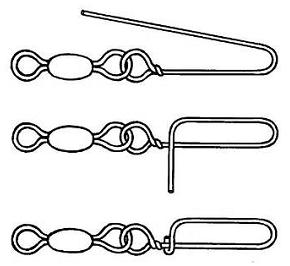|
Making Fishing LeadersMaking The Weakest Link
|
The length of the nylon monofilament leader will depend on the tackle you use. Generally, it should be long enough so that when you reel in most of your line and are ready to cast again there are a few turns of the leader on your reel.
In other words, making fishing leaders run from the reel to the rod tip and beyond to the lure is necessary. When you cast, most of the shock will be absorbed by the stronger leader instead of the weaker fishing line.
So, most such fishing leaders will run from 6 ft. for the shorter, lighter spinning rods to 12 or 15 ft. for the longer, heavier spin rods and surf rods. For trolling, such long leaders are of course not needed, and you can usually use shorter ones.
When making fishing leaders , you must know how to tie good, strong fishing knots. A knot is the weakest link in your line or leader.
Even a perfectly tied knot weakens a line, but a wrong or carelessly tied knot can weaken your line or leader by as much as 50 per cent or more. A good knot, properly tied, weakens the line by only 20 per cent or so.
In order to save fishing time it pays in making fishing leaders in advance, tying a loop on one end and attaching a swivel and snap on the other end.
Then coil the leader and put it into a separate paper, cellophane, or glassine envelope. It's a good idea to mark the strength of the leader on the envelope somewhere, so you don't get confused later on.
When fishing in fresh water for pike and muskellunge and for many saltwater fish you need wire leaders ahead of the lure to prevent these fish from biting your nylon leader.
When surf fishing it's also a good idea to attach a short wire leader to all your fishing lures such as metal squids and plugs. See illustration below. Then tie a swivel-snap on your line for changing the lures. Such a short wire leader can run anywhere from 6 to 10 in. in length.

When making fishing leaders, various kinds of snaps, swivels, and other connections are often required in freshwater and saltwater fishing. Of course, you can tie nylon leaders directly to the lures, and this is most effective in clear water or when fishing for wary fish.
When changing lures, however, this often takes too much time and effort, so most anglers resort to some kind of snap and swivel on the end of the leader. Such snaps and swivels can be bought in most fishing tackle stores.
You can also make your own quick-change locking snaps with little trouble, using stainless steel single-strand wire. Use the finer wire for freshwater snaps and heavier gauges for saltwater snaps.
For the freshwater snaps use the small round nose pliers . Form an eye, as described in making wire leaders, but slip on a barrel swivel before you close this eye permanently by making about two twists.
Next, grab the wire with the round nose pliers about a half inch or so from the eye. The actual distance will depend on the size of the snap you want.
Now make a round bend at this point, turning the wire toward the eye. Next, grab the wire again with the pliers, near the eye, and make a sharp bend to force the wire back toward the twists next to the eye.
Finally, take the short end of the wire with pliers and form a catch. In other words, the wire starts from the eye, runs straight for a half inch or so, curves to form a round end and runs back parallel, curves sharply, and meets itself. The illustration below will show the various steps in forming the snap-swivels.

Snap-swivels in various sizes for freshwater or saltwater fishing can be made up in advance, say during the winter months, for the coming fishing season.
They are much cheaper than those you buy in a fishing tackle store, and they are just as strong and efficient. Most important, if you lose a few of them while fishing they are easily replaced at little cost.
|
| Freshwater Fishing | Bass Fishing | Saltwater Fishing | | Fishing Spoons | Fishing Spinners | Fishing Jigs | | Sinkers | Making Fishing Leaders | Hand Tools | | Link To Us | Contact Us | Preferred Partners | About This Site | | Site Map | |
| Back to Top |
Make-Your-Own-Fishing-Lures.com
© 2004 Make-Your-Own-Fishing-Lures.com. All Rights Reserved.



